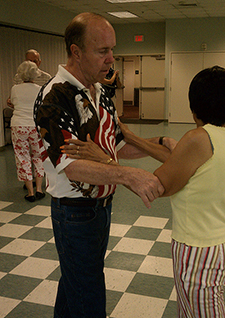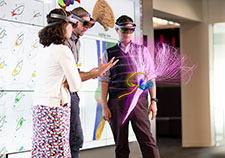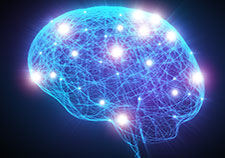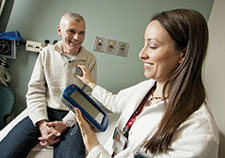Office of Research & Development |
 |
Office of Research & Development |
 |


Dr. Madeleine Hackney, a research health scientist with VA, says the tango "involves spatial awareness, motor control, balance, memory, and coordination to music and with a partner." (Photo ©iStock/dolphinphoto)
September 27, 2017
By Mike Richman
VA Research Communications

Bill Barsin has taken part in tango classes at the Atlanta VAMC to help his Parkinson's symptoms. (Photo courtesy of Dr. Madeleine Hackney)
Bill Barsin has what he calls “moderate to heavy duty” Parkinson’s, a neurodegenerative disorder that short-circuits the body’s motor system. The Army Vet often has trouble lifting his feet when he tries to walk, struggles with balance, and experiences slurred speech and short-term memory loss. Dementia can occur in the advanced stages of the disease.
“I freeze when I walk,” he says. “It’s like I can’t move.”
Barsin, 70, who has been battling the disease for 16 years, is on medication and has had a brain stimulation operation. That procedure delivers electrical stimulation to areas of the brain that control movement, blocking the abnormal nerve impulses that cause Parkinson’s symptoms.
As a form of rehabilitation, he’s also completed dance classes aimed at improving mobility, walking, and balance. In fact, he’s been doing the tango.
Most recently, Barsin was one of 20 people with a mild to moderate case of Parkinson’s disease (PD), including several Veterans, who participated in tango classes at the Atlanta VA Medical Center. The classes called for 1.5 hours of dancing per day, five days a week, over a three-week period, for a total of 22.5 hours of dance time. The Veterans and other participants learned and practiced adapted tango, a modified version of the popular Argentine tango. The modified form was designed by Dr. Madeleine Hackney – a research health scientist at the Atlanta VA who specializes in improving physical function in people with PD – to address the patients’ physical limitations.
The classes led to a study, published in July 2017 in the Journal of Neurophysiology, that examined changes in muscle coordination linked to improved motor performance in people with mild to moderate Parkinson’s. The researchers show that the classes triggered improvements in neuromuscular control in the participants’ abilities to walk and gain balance. They also find similarities between the motor skills in healthy people and the gains in muscle coordination that stem from the motor skills reacquired through the tango classes.
Hackney co-authored the study. She says tango includes elements that make it conducive for improving the condition of someone with Parkinson’s.
“Tango is multimodal and involves spatial awareness, motor control, balance, memory, and coordination to music and with a partner,” she says. “Perhaps by working on the novel steps with a partner, people with PD were able to challenge themselves positively, leading to the brain’s ability to reorganize itself by forming new neural connections.”
She adds: “It is known that exercise is vital for people with Parkinson’s, and tango is a moderate exercise. The high volume of tango in this study might have contributed to positive outcomes. Also, the tango classes were taught in a group, and the peer support may have fostered functional benefits.”
Hackney says it was important to use a modified version of Argentine tango.
"In adapted tango, partners hold elbows, rather than the traditional 'hugging' dance frame that we see in pictures or on the dance floor."
“Argentine tango is a beautiful dance and wonderful for sophisticated communication of motor goals,” she says. “But I needed to modify some of the steps so they would be feasible for people with Parkinson’s, some of whom have pretty severe balance and walking impairments. A big difference between Argentine tango and adapted tango is the embrace. In adapted tango, partners hold elbows, rather than the traditional `hugging’ dance frame that we see in pictures or on the dance floor.”
Barsin says the adapted tango classes consist of 15 to 20 different steps, including a box step that calls for putting your right foot behind your left foot, then bringing it up. “It’s a nice fluid step, and if you work on it enough you feel fluid,” he says.
According to the National Institutes of Health, Parkinson’s disease affects at least 500,000 Americans, mostly people over age 50. VA estimates that 80,000 Veterans have the disease, for which there is no cure. In 2010, VA recognized Parkinson’s as being associated with exposure to Agent Orange or other herbicides during military service. Veterans who meet the criteria may be eligible for disability compensation and health care.

Brain organoids: Emerging method to study brain diseases

Gaining insight into Parkinson's

Home use test of brain-computer interface for ALS patients yields 'complicated' results

Deep brain stimulation linked to longer survival for Parkinson's patients
Barsin spent two years in Vietnam in the mid- to late-1960s. He was with the Army’s 101st Airborne Division near the demilitarized zone, the area around the dividing line between North Vietnam and South Vietnam. He also served as a helicopter door gunner along the Mekong Delta in South Vietnam. He’s not sure if the U.S. military used Agent Orange to defoliate forests that were close to him.
“But it could have happened,” he says. “It probably did. If it was there, I was exposed to it.”
This isn’t the first time Hackney and her colleagues demonstrated that adapted tango can improve balance and walking in people with mild to moderate PD. The team showed positive results in 2009 in a two-week “boot camp” with people coming five days a week for 1.5-hour daily lessons — a total of 15 hours; and in 2013 in a 12-week, 20-session program at 1.5 hours per class for a total of 30 hours. In the most recent study, she says, the researchers considered whether a longer dose of “boot camp” would be helpful.
“So we had participants come for three weeks and complete 22.5 hours of training,” she says. “Importantly, we were also very interested if there were any changes on a neural level as a result of the tango lessons, or changes to the nervous system that would accompany the clinically measured changes. If we see changes on a neural level, that’s suggesting the results are based on physiology, rather than on behavioral change. That would suggest longer-lasting, more dramatic effects.”
Each of the 20 participants completed the 22.5-hour, three-week course. They had an average age of 68. “That’s a relatively high volume of exercise for this population,” Hackney says.
The study centered on the concept of motor modules, which are groups of muscles that are called on by the nervous system to perform certain tasks. Each motor module is recruited to produce a specific phase of movement, such as forward propulsion for walking. Thus, motor modules are like “building blocks” that can be combined to meet the demands of movements like walking and running, according to Hackney and co-authors Dr. Jessica Allen and Dr. Lena Ting.
The researchers also looked at motor module number, which is the number of “building blocks” that are recruited for a specific movement. Recruiting too few motor modules may result in the inability to meet the demands of a movement. More motor modules are associated with better motor performance, the researchers say.
“For example, individuals post-stroke typically recruit too few motor modules during walking, which is accompanied by slower walking speeds and unusual walking patterns,” Hackney says. “With these people, increasing the number of motor modules with rehabilitation leads to better walking performance.”
Hackney explains that each participant was already recruiting the right number of motor modules for walking and balance prior to the dance classes. But that doesn’t mean they were the correct motor modules, she says.
The researchers used motor module distinctness as one of the metrics to examine what the motor modules look like.
“A higher value of motor module distinctness means that an individual recruits motor modules that are more well-defined and different from each other,” Hackney says. “Recruiting a well-defined motor module is critical for producing well-defined, mechanically sound functional output. Therefore, recruiting motor modules that are more distinct from each other may result in better supporting the functional demands of a movement, leading to better motor performance.”
Hackney and her team also measured motor module generalizability, or seeing if the same modules are recruited for different movements, in this case walking and balance. For example, non-impaired young adults recruit the same modules to meet demands such as keeping the rear end upright for control of both walking and balance.
After three weeks of tango classes, the researchers found that the cohort did not increase motor module number but did increase motor module distinctness. That means the participants learned to group muscles together in a different way to better meet the functional demands of walking and balance, Hackney says. The researchers also found that the motor modules recruited for walking became much more similar to those recruited for balance. The cohort recruited very different modules prior to the classes, she says.
To identify positive changes related to walking and balance, the researchers attached electrodes to the body. They then measured the electrical activity that comes from muscles in the trunk and leg as a person performed a movement. That recording provided patterns of activity for each muscle. The researchers used statistical techniques to group the muscles into motor modules.
For Bill Barsin, this was his third round of adapted tango classes under the direction of Hackney and her colleagues. He says he can feel an immediate benefit from the classes while they are taking place and for a short time after. But he notes that the gains dissipate if he fails to practice the steps.
“The classes train you through dancing to keep track of where your feet are,” he says. “I’m not looking down at my feet when I finish one of those classes. I’m being trained to put my feet down in a way in which I memorize where they’re supposed to be. It works out pretty good.”
Barsin also appreciates the peer support that exists in the classes. “You find out what’s going on in the Parkinson’s community, and you make friends there,” he says.
VA Research Currents archives || Sign up for VA Research updates